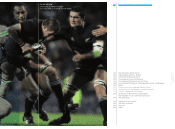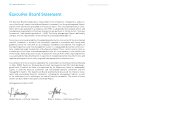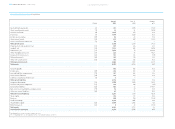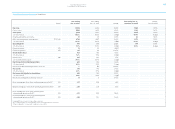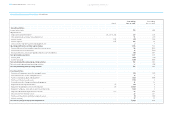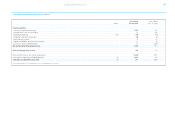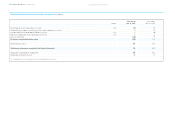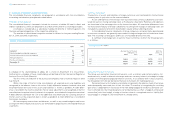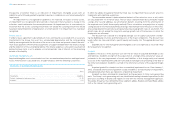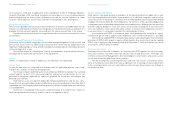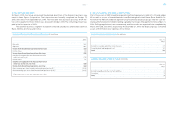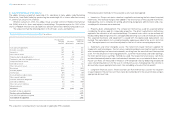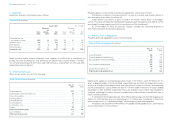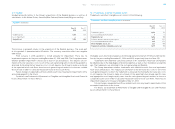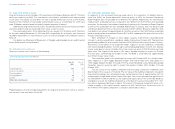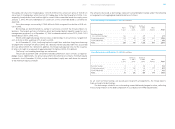Reebok 2006 Annual Report Download - page 155
Download and view the complete annual report
Please find page 155 of the 2006 Reebok annual report below. You can navigate through the pages in the report by either clicking on the pages listed below, or by using the keyword search tool below to find specific information within the annual report.
Notes ›151
Changes in the fair value of derivatives that are designated and qualify as cash flow hedges,
and that are 100% effective, as defined in IAS 39, are recognized in equity. Insofar as the effec-
tiveness is not 100%, the ineffective part of the fair value is recognized in net income. Cumu-
lated gains and losses in equity are transferred to the income statement in the same periods
during which the hedged forecasted transaction affects the income statement.
For derivative instruments designated as fair value hedges, the gain or loss on the de-
rivatives and the offsetting gains or losses on the hedged items are recognized immediately
in net income.
Certain derivative transactions, while providing effective economic hedges under the
Group’s risk management policies, do not qualify for hedge accounting under the specific rules
of IAS 39. Changes in the fair values of any derivative instruments that do not qualify for hedge
accounting under IAS 39 are recognized immediately in the income statement.
Hedges of net investments in foreign entities are accounted in a similar way to cash flow
hedges. If the hedging instrument is a derivative (e.g. a forward contract) or, for example, a
foreign currency borrowing, effective currency gains and losses in the derivative and all gains
and losses arising on the translation of the borrowing, respectively, are recognized in equity.
The Group documents the relationship between hedging instruments and hedged items
at transaction inception, as well as the risk management objective and strategy for undertak-
ing various hedge transactions. This process includes linking all derivatives designated as
hedges to specific forecasted transactions. The Group also documents its assessment whether
the derivatives that are used in hedging transactions are highly effective by using different
methods of effectiveness testing, such as the dollar offset method or the hypothetical deriva-
tive method.
The fair values of forward contracts and currency options are determined on the basis of
the market conditions on the reporting dates. The fair value of a currency option is determined
using generally accepted models to calculate option prices. The fair market value of an op-
tion is influenced not only by the remaining term of the option but also by further determining
factors, such as the actual foreign exchange rate and the volatility of the underlying foreign
currency base. The fair values of interest rate options on the reporting date are assessed by
generally accepted models, such as the “Markov functional model”.
Cash and Cash Equivalents
Cash and cash equivalents represent cash and short-term bank deposits with maturities of
three months or less from the date of acquisition.
Receivables and Other Assets
Receivables are recognized at fair value, which is estimated as the present value of future cash
flows discounted at the market rate of interest at the balance sheet date. If necessary, required
allowances are determined on the basis of individual risk assessment and past experience of
losses.
Inventories
Merchandise and finished goods are valued at the lower of cost or net realizable value. Costs
are determined using a standard valuation method: the first-in, first-out method or the
average cost method. Costs of finished goods include cost of raw materials, direct labor and
manufacturing overheads. The lower of cost or net realizable value allowances are computed
consistently throughout the Group based on the age and expected future sales of the items on
hand.
Assets/Liabilities Classified as Held-for-Sale
Assets and liabilities (primarily non-current) that are expected to be recovered principally
through sale rather than through continuing use are classified as held-for-sale. These are
measured at the lower of their carrying amount and fair value less cost to sell.
Property, Plant and Equipment
Property, plant and equipment are stated at cost (which comprises any costs directly attrib-
utable to bringing the asset to the condition necessary for it to be capable of operating in
the manner intended by Management) less accumulated depreciation (except for land) and
accumulated impairment losses. Depreciation is computed by the straight-line method, except
where the declining-balance method is more appropriate in light of the actual utilization pat-
tern. Useful lives are as follows:
Expenditures for maintenance and repairs are expensed as incurred. Renewals and improve-
ments are capitalized and depreciated separately, if the recognition criteria are met.
Impairment
In the event that facts and circumstances indicate that the costs of non-current assets (finan-
cial and non-financial assets) are impaired, an evaluation of recoverability is performed. An
impairment loss is recognized in the income statement if the carrying amount exceeds the
recoverable amount. If there is an impairment loss for a cash-generating unit, first the carry-
ing amount of any goodwill allocated to the cash-generating unit is reduced, and subsequently
the other assets of the unit are reduced pro rata on the basis of the carrying amount of each
asset in the unit.
Useful Lives of Property, Plant and Equipment
Years
Buildings 10 – 50
Leasehold improvements 5 – 20
Technical equipment and machinery as well as other equipment and furniture and fittings 2 – 10


